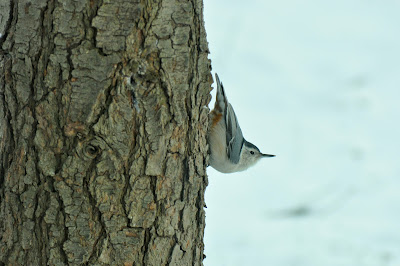Varied Thrush
If you look up the term “birder” in certain
dictionaries, you’ll discover it can mean “kindness to strangers.” Today,
Susan and I saw proof of it. We went searching for an extremely rare
Varied Thrush that has chosen Ohio for a winter vacation.
The Varied Thrush is a bird of the Pacific
Northwest. Occasionally one will show up in this area and when it does, alarms
sound and flash all over the region. The species is so outstanding,
author/artist David Sibley chose the Varied Thrush out of more than 900 birds in North America to grace the cover of his Western Field Guide.
The bird in question showed up on the feeder of a
young Amish couple, Naomi and Michael Yoder in Fresno, Ohio, a place so deep in the Amish
community it doesn’t even show on most maps. For us it was
about a 90-minute drive through some of finest scenery Ohio has to offer.
Using directions posted on the Ohio Ornithological
Society listserv, we found the house and drive with ease. Well, ease because we have a four-wheel drive vehicle. And much to our delight, as we got out of the car, the bird was teed-up on the edge of the
feeder, 50 yards away, giving us great, but too-brief looks.
After the bird flew and we did our high-five thingy,
I spoke with Michael, a nicer young man you could not hope to meet. He was
carrying a guest register and politely asked the dozen or so other birders to
sign in. He excitedly told me the story of Naomi finding the bird and I suspect he’s told
it many times. The guest register had more than 125 names on it, but it’s still
early. As the word spreads those pages will fill.
We waited around in the 25-degree temperatures for
about 20 minutes until Michael invited everyone into his house. He said the
bird takes hour-long breaks so why not wait inside? This is the third day he’s
been inviting strangers in to warm up. He told me that this morning about 30 people crowded into the small area off the kitchen, the best spot to watch the
feeder.
The plethora of birds around the feeding station was
amazing. It was while looking at a Brown Creeper that Michael spotted the
thrush and got it in his spotting scope, giving us all great looks.
The Varied Thrush is one of those birds that neither
words nor pictures can truly describe. Its mix of orange and black, the
intricate patterns on its wings and sides …
Well, you have to see it to believe it, and even
then you might not believe it. And when you read about people like Naomi and
Michael Yoder, well you have to see them to believe it, too.
Varied Thrush might have been the main attraction, however, the variety of birds at the feeder while waiting for the thrush was amazing. Here, an Eastern Bluebird and Northern Cardinal. We had 24 species for the day.














